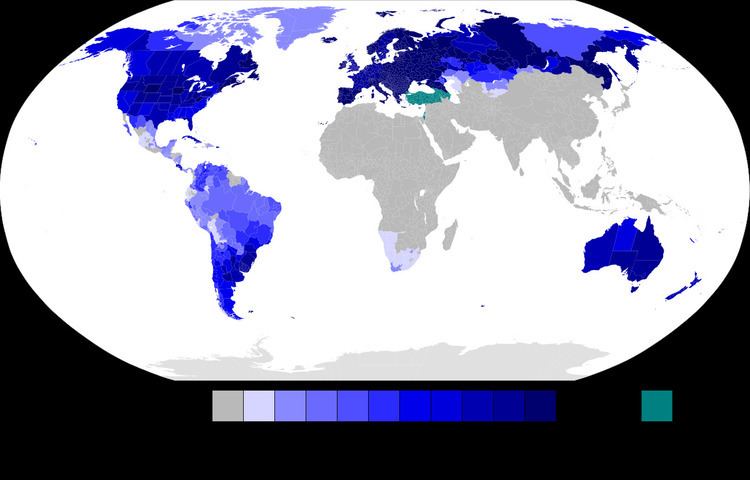United States 223,553,265 Argentina 38,900,000 Australia 20,982,665 | Brazil 98,051,646 Canada 25,186,890 Mexico 20,100,000+ | |
 | ||
European emigration or European diaspora consists of the people and their descendants who have emigrated from Europe.
Contents
- Scale of Emigration
- Post independence emigration
- By region
- Africa
- Asia
- Americas
- Europeans in Latin America and the Caribbean
- Oceania
- Potential emigrants
- References
From 1815 to 1932, 60 million people left Europe (with many returning home), primarily to "areas of European settlement" in the Americas (especially to the United States, Canada, Brazil, the Southern Cone such as Argentina, and Uruguay), Australia, New Zealand and Siberia. These populations also multiplied rapidly in their new habitat; much more so than the populations of Africa and Asia. As a result, on the eve of World War I, 38% of the world’s total population was of European ancestry.
Scale of Emigration
The discovery of the Americas in 1492 stimulated a steady stream of voluntary migration from Europe. About 200,000 Spaniards settled in their American colonies prior to 1600, a small settlement compared to the 3 to 4 million Amerindians who lived in Spanish territory in the Americas but then it grew the number of Spanish immigrants in addition to other European population of Romance language (French and Italian). In Brazil the European emigration remained very small in the first two centuries of colonization: between 1500 and 1700, only 100,000 Portuguese settled there. However, the development of the mining economy in the 18th century raised the wages and employment opportunities in the Portuguese colony and the emigration grew: in the 18th century alone, about 600,000 Portuguese settled in Brazil, a mass emigration given that Portugal had a population of only 2 million people. In North America the immigration was dominated by British, Irish and other Northern Europeans.
Post-independence emigration
Mass European emigration to the Americas happened in the 19th and 20th centuries. After the end of the Napoleonic Wars until 1920, some 60 million Europeans (and 10 million Asians) emigrated. Of these, 71% went to North America, 21% to Latin America (mainly Argentina and Brazil) and 7% to Australia. About 11 million of these people went to Latin America, of whom 38% were Italians, 28% were Spaniards and 11% were Portuguese.
Between 1821 and 1880, 9.5 million Europeans settled in the United States, mainly Germans and Irish. Other waves included British and Scandinavian people. Despite the large number of immigrants arriving, people born outside of the United States formed a relatively small number of U.S. population: in 1910, foreigners were 14.7% of the country's population. Nothing similar to what happened in Argentina, which was the American country where immigrants had a larger impact in the ethnic composition. By 1914, 30% of Argentina's population was foreign-born, with 12% of its population born in Italy, the largest immigrant group. Next was Canada: by 1881, 14% of Canada's population was foreign-born, and the proportion increased to 22% in 1921. In Brazil the proportion of immigrants in the national population was much smaller, and immigrants tended to be concentrated in the central and Southern parts of the country. The proportion of foreigners in Brazil peaked in 1920, with just 7%, mostly Italians, Portuguese, and Spaniards. In 1901–1920 immigration was responsible for only 7 percent of Brazilian population growth but in the years of high immigration, 1891–1900, the share was as high as 30 percent (higher than Argentina's 26% in the 1880s).
The countries in the Americas that received a major wave of European immigrants from the mid-1800s to the mid-1900s were: the United States (32.6 million), Argentina (6.5 million), Canada (5.1 million), Brazil (4.4 million), Cuba (1.4 million), Uruguay (713,000). Other countries received a more modest immigration flow (accounting for less than 10% of total European emigration to Latin America) were: Mexico (270,000), Colombia (126,000), Chile (90,000), Puerto Rico (62,000), Peru (30,000), and Paraguay (21,000).
By region
Nations and regions outside of Europe with significant populations of European ancestry:
Africa
(South Africans of European descent): 4,586,838 (8.9% of South Africa's population) (Spaniards who settled the Canary Islands, Canary Islanders.
Asia
Siberia: (Russians)
The Middle East Small communities of European, white American and white Australian expatriates in the Persian Gulf countries like Bahrain, Kuwait, Qatar and the UAE; and in Aramco compounds in Saudi Arabia. Historically before 1970, small ethnic European (esp. Greek and Italian) enclaves were found in Egypt (Greeks in Egypt, Italian Egyptians) and Syria (Greeks in Syria).
Americas
Total European population in the Americas—approximately 446,394,000
Europeans in Northern America Northern America –-- Total European population approximately 249,300,000 (European Canadian) – Canada 2011 Census reported 61% of the population, or 20,000,000 people, mostly divided into Anglophone (18 million) and Francophone (10 million). (European American) – 72.4% of the population, or 223,800,000
Europeans in Latin America and the Caribbean
Middle America (including Central America and the Caribbean) and South America (see Latin Americans of European descent) -- Total European population approximately 197,094,000 Argentina: 79% of the population or 38,900,000, may include an unknown percentage of mestizos and mulattos. Other sources put 86.4% of the population. Falkland Islanders mainly European of British descent—total population 3,140.
Oceania
Oceania - Total population of Europeans in Oceania is approximately 23,185,000 or approximately 22,818,000 excluding Hawaii. (European Australians and New Zealanders)
Potential emigrants
According to a 2010 Gallup study, an estimated 80 million adults in the European Union would prefer to emigrate if given free choice. About half of these would migrate to another country within the EU. The remaining 40 million have a desired destination outside of the EU, about 14 million would migrate to North America (USA or Canada), and 9 million to Australia or New Zealand.
